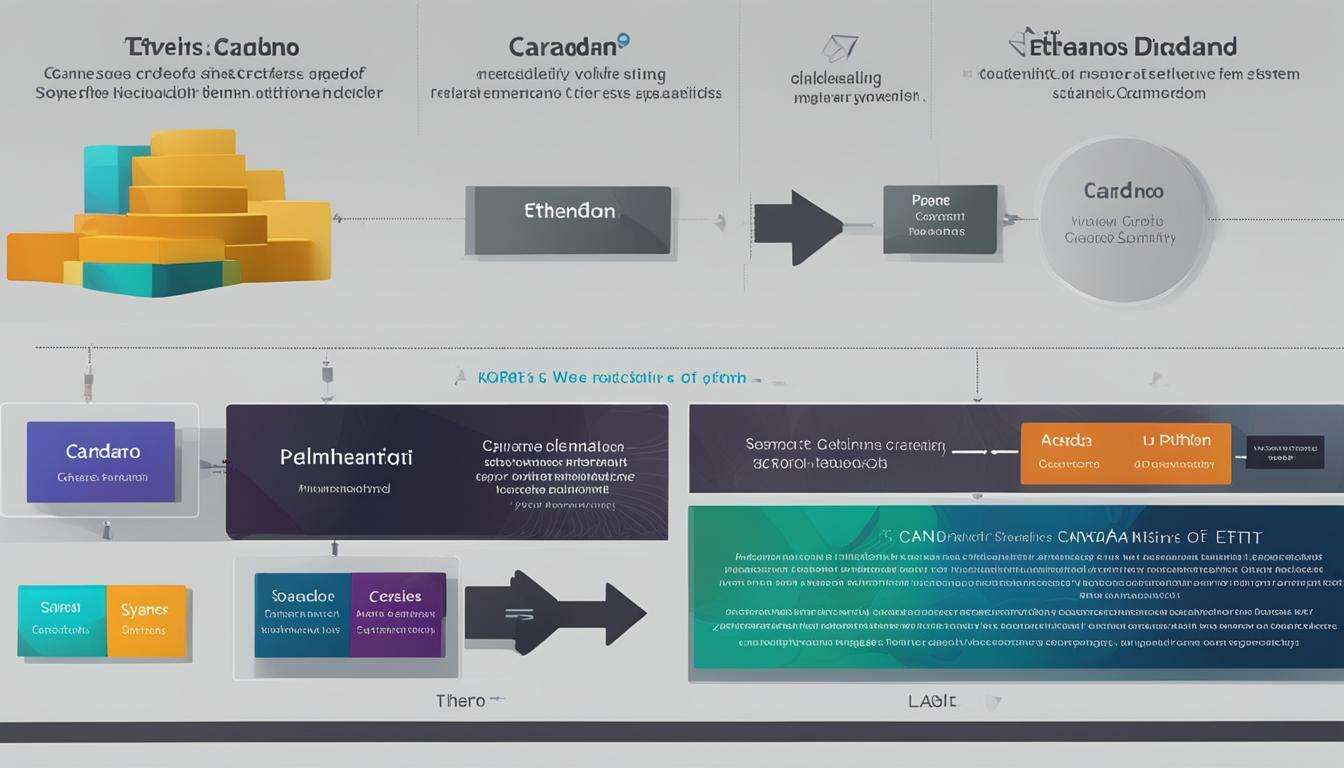
The world of blockchain and cryptocurrency has seen the emergence of two prominent players – Cardano and Ethereum. Both platforms have generated a considerable amount of buzz in the market and have amassed a significant following among enthusiasts and investors alike.
Cardano and Ethereum are not just digital currencies; they offer a whole ecosystem of platforms built on blockchain technology that enables developers to create decentralized applications and execute smart contracts. However, both platforms have distinctive features and differences that set them apart from each other.
In this comprehensive comparison, we will explore the fundamental differences between Cardano and Ethereum. We will delve into their underlying blockchain technology, the staking mechanisms, their milestones, unique features, and innovations, to mention a few.
- Cardano and Ethereum are two leading blockchain platforms, each with its unique features and innovations.
- Both platforms enable the creation of decentralized applications and execution of smart contracts, but with different underlying blockchain technology.
- Staking plays a significant role in securing the networks and facilitating transaction validation on both platforms.
- Cardano’s focus on research-driven development, the use of formal verification, and multi-layered blockchain approach sets it apart from Ethereum.
- Ethereum’s first-mover advantage, extensive ecosystem of decentralized applications (dApps), and network effect have provided an advantage in terms of adoption and development.
Page Contents
- 1 Understanding Cardano and Ethereum
- 2 Exploring Smart Contracts and Decentralized Finance
- 3 A Closer Look at Proof of Stake Consensus Mechanisms
- 4 Cardano’s Shelley Era and Ethereum’s Ongoing Evolution
- 5 Unique Features and Innovations of Cardano
- 6 Ethereum’s Market Dominance and Ecosystem
- 7 FAQ
- 7.1 What is Cardano and Ethereum?
- 7.2 What are smart contracts and decentralized finance (DeFi)?
- 7.3 How do Cardano and Ethereum compare in terms of proof of stake consensus?
- 7.4 What are the significant milestones in Cardano’s Shelley era and Ethereum’s ongoing evolution?
- 7.5 What are some unique features and innovations offered by Cardano?
- 7.6 What advantages does Ethereum’s market dominance and ecosystem provide?
- 7.7 What is the conclusion of the Cardano vs. Ethereum comparison?
Understanding Cardano and Ethereum
Cardano and Ethereum are two of the most prominent blockchain platforms in the cryptocurrency market. They share several similarities, but also have notable differences that set them apart.
At their core, both Cardano and Ethereum operate on blockchain technology, which is a decentralized and immutable ledger that records transactions securely and transparently. However, while Ethereum was launched in 2015, Cardano only came to market in 2017 and has since been gaining traction as a viable alternative to Ethereum.
Cryptocurrency is an essential aspect of both platforms. Ethereum’s currency is called Ether (ETH), while Cardano’s currency is ADA. Both cryptocurrencies can be traded on various exchanges and stored in digital wallets.
Cardano
Cardano is a blockchain platform that was developed by IOHK, a blockchain research and development company. The platform is built on a multi-layered blockchain architecture that separates transaction recording from smart contract execution.
One of Cardano’s unique features is its research-driven development approach, which means that updates and upgrades to the platform are based on scientific research and peer-reviewed academic papers. Additionally, Cardano uses formal verification, a mathematical method for ensuring that smart contracts are secure and error-free.
Cardano’s blockchain is powered by the Ouroboros proof-of-stake consensus mechanism, which relies on staking rather than mining to validate transactions and secure the network. Staking involves holding a certain amount of ADA tokens in a digital wallet for a specified period to receive rewards and participate in network governance.
Ethereum
Ethereum is a decentralized blockchain platform that enables the creation and execution of smart contracts and decentralized applications (dApps). It was founded by Vitalik Buterin, a Canadian-Russian cryptocurrency researcher, in 2014.
Ethereum’s blockchain is powered by the proof-of-work consensus mechanism, which relies on miners to validate transactions and secure the network. However, the platform has been in the process of transitioning to a proof-of-stake mechanism called Ethereum 2.0, which aims to improve scalability and reduce energy consumption.
Ethereum’s first-mover advantage and extensive ecosystem of dApps and tokens have contributed to its market dominance in the cryptocurrency industry. It is often regarded as the second-most valuable cryptocurrency after Bitcoin.
“At their core, both Cardano and Ethereum operate on blockchain technology, which is a decentralized and immutable ledger that records transactions securely and transparently.”
Exploring Smart Contracts and Decentralized Finance
Smart contracts and decentralized finance (DeFi) have become a significant trend in the blockchain and cryptocurrency industry. Cardano and Ethereum are two platforms that have enabled the creation and execution of smart contracts, paving the way for DeFi applications.
Smart contracts are self-executing programs that facilitate the exchange of assets or information between parties, without the need for intermediaries. They operate on blockchain networks and are immutable, transparent, and secure. Smart contracts have numerous applications, including digital identity, supply chain management, and decentralized exchanges.
DeFi, on the other hand, refers to a financial system built on the blockchain, providing financial services without the need for intermediaries, such as banks or exchanges. It enables users to access financial services, such as lending, borrowing, and trading, in a decentralized and transparent manner.
Cardano and Ethereum’s smart contract capabilities have enabled the development of DeFi applications on their platforms. Cardano’s Plutus programming language allows developers to write smart contracts in Haskell, a functional programming language known for its reliability and security. Ethereum’s Solidity language, on the other hand, is a high-level language that enables developers to write smart contracts that run on the Ethereum Virtual Machine (EVM).
The smart contract capabilities of Cardano and Ethereum have given rise to numerous DeFi applications. Cardano’s support for multi-currency ledger and interoperability with other blockchain networks, such as Bitcoin, makes it an attractive platform for DeFi applications. Ethereum, on the other hand, has a more extensive ecosystem of DeFi applications, such as decentralized exchanges like Uniswap and lending platforms like Aave.
“Smart contracts and DeFi have the potential to disrupt traditional finance and revolutionize the way we transact and exchange value. Cardano and Ethereum are at the forefront of this transformation, providing a robust and secure platform for the development of DeFi applications.”
A Closer Look at Proof of Stake Consensus Mechanisms
The consensus mechanism is the fundamental protocol that enables the validation of transactions and the creation of new blocks on the blockchain. While both Cardano and Ethereum utilize a proof-of-stake (PoS) consensus mechanism, there are significant differences in their implementation and approach.
Cardano’s Ouroboros PoS
Cardano’s Ouroboros PoS is a highly energy-efficient consensus mechanism that helps secure the network and facilitates transaction validation. It operates by selecting a leader node that creates a new block, and a committee that verifies the transaction and approves it for inclusion in the blockchain. The Ouroboros algorithm ensures that the probability of a malicious node corrupting the network is minimal.
Moreover, Cardano’s PoS mechanism allows users to participate in staking and earn rewards for securing the network and validating transactions. Staking involves depositing ADA, the native cryptocurrency of Cardano, to participate in the consensus process and receive a share of the transaction fees and block rewards.
Ethereum’s PoS Mechanism
Ethereum’s PoS mechanism, known as Ethereum 2.0 or Eth2, is a significant upgrade from its previous proof-of-work (PoW) consensus algorithm that required massive computational power and energy consumption. Eth2 aims to be more energy-efficient and facilitate faster transaction processing while maintaining high-level security.
Similar to Cardano, Eth2 operates by selecting validators that process transactions and create blocks on the blockchain. Validators need to stake a minimum of 32 ETH to participate in the consensus process and earn rewards for their work.
Staking on Cardano and Ethereum
Both Cardano and Ethereum offer staking as a way for users to participate in the consensus process and earn rewards. However, there are some significant differences in their staking models.
Cardano’s staking model involves a delegation mechanism that allows ADA holders to delegate their stake to a pool operator that performs the validation process on their behalf. The pool operator shares the rewards with delegators, with the distribution ratio determined by the pool’s performance and the number of stake delegators.
Ethereum’s staking model, on the other hand, is based on a more individualistic approach, where validators operate independently and receive rewards directly based on their contributions to the network.
Overall, while Cardano and Ethereum share many similarities regarding their PoS consensus mechanism, they differ significantly on their approach to staking and network validation. Both projects are making significant progress in upgrading their respective networks, and only time will tell which one will emerge as the leader in the highly competitive blockchain landscape.
Cardano’s Shelley Era and Ethereum’s Ongoing Evolution
Cardano’s Shelley era and Ethereum’s continuing evolution mark significant milestones in the development of these two blockchain platforms.
Cardano’s Shelley era is an essential step in Cardano’s development, focusing on decentralization, security, and scalability. The Shelley era introduced the Ouroboros network protocol, a proof-of-stake mechanism that enables Cardano to operate securely and efficiently. The Ouroboros network protocol provides an energy-efficient way of verifying transactions without the need for costly mining rigs.
Moreover, the Shelley era introduced staking, which allows Cardano holders to earn rewards by participating in the Cardano network. The Ouroboros algorithm selects validators who are responsible for validating transactions, adding blocks, and maintaining the network’s security.
Ethereum is continually evolving, with developers introducing upgrades to address the network’s scalability and security issues. The current Ethereum network uses a proof-of-work consensus mechanism, similar to Bitcoin. However, Ethereum developers are working toward transitioning to a proof-of-stake consensus mechanism, which will allow for increased scalability, energy efficiency, and security. The Ethereum 2.0 upgrade, which includes the implementation of the Beacon Chain, provides a foundation for the transition to proof-of-stake.
Moreover, Ethereum developers are also exploring Layer 2 solutions, such as sidechains, state channels, and plasma, to address scalability concerns. These Layer 2 solutions enable developers to build decentralized applications (dApps) that operate efficiently without congesting the Ethereum mainnet network.
Overall, both Cardano and Ethereum are continuously improving and evolving to meet the challenges of the rapidly changing blockchain landscape. The Shelley era and Ethereum 2.0 upgrade highlight the significant milestones in the development of these two blockchain platforms, and their future directions remain exciting to observe.
Unique Features and Innovations of Cardano
Cardano is an innovative blockchain platform that offers unique features in the cryptocurrency market. With its ADA cryptocurrency, Cardano aims to provide a more secure, sustainable, and scalable network than its competitors. Here are some of the standout features that make Cardano a unique and promising project:
Multilayered Blockchain Approach
Cardano’s multilayered blockchain approach sets it apart from other blockchain platforms, including Ethereum. Cardano’s approach separates the network into two distinct layers: the settlement layer and the computation layer. The settlement layer is responsible for handling transactions, while the computation layer is reserved for executing smart contracts. This approach allows for better scalability and security, as each layer can be optimized for its respective function.
Research-Driven Development
Cardano places a great emphasis on research-driven development, with a team of scientists and engineers working on the platform’s evolution. This approach ensures that Cardano makes educated decisions when introducing new features and upgrades to the network. Additionally, Cardano uses formal verification, a rigorous mathematical process that eliminates the possibility of bugs and errors in the code, ensuring a more secure and reliable network.
ADA Cryptocurrency
The ADA cryptocurrency is the backbone of the Cardano network. It is used to pay transaction fees, execute smart contracts, and transfer value. The ADA cryptocurrency has a fixed supply of 45 billion, and over 70% of it is currently in circulation. Cardano’s unique consensus mechanism, Ouroboros, allows for the staking of ADA, giving stakeholders a say in the network’s development and decision-making process.
Cardano aims to provide cross-chain interoperability, allowing different blockchains to interact and share data with one another. This feature is particularly important for the future of decentralized finance (DeFi) and the broader adoption of blockchain technology.
Scalability
Cardano is designed to be a highly scalable platform, capable of handling a vast number of transactions per second (TPS) without compromising security or decentralization. Cardano’s current TPS already surpasses that of Ethereum, and the platform’s future upgrades aim to increase its capabilities even further.
Conclusion
Cardano’s unique features and innovations make it a promising blockchain project in the cryptocurrency market. With its focus on research-driven development, multilayered blockchain approach, and interoperability, Cardano aims to provide a secure and scalable platform for decentralized applications and transactions. Its ADA cryptocurrency and consensus mechanism, Ouroboros, provide a unique opportunity for stakeholders to participate in the network’s decision-making process and development. With further advancements and upgrades, Cardano has the potential to become a major player in the evolving cryptocurrency landscape.
Ethereum’s Market Dominance and Ecosystem
Ethereum is currently the dominant player in the blockchain and cryptocurrency space, with a market capitalization of over $400 billion as of August 2021. Ethereum’s first-mover advantage and strong network effect have given it significant momentum in terms of adoption and development.
One of the key advantages of Ethereum’s ecosystem is its extensive network of decentralized applications (dApps) and tokens. Ethereum’s smart contract functionality has enabled the creation of a wide range of innovative projects, from decentralized finance (DeFi) platforms to non-fungible tokens (NFTs) and beyond.
| Ethereum’s Market Dominance and Ecosystem | |
|---|---|
| Market capitalization | $400 billion (August 2021) |
| Strengths | First-mover advantage, strong network effect, extensive ecosystem of dApps and tokens |
| Weaknesses | Scalability issues, reliance on proof of work consensus mechanism |
However, Ethereum’s dominance is not without its weaknesses. The platform has struggled with scalability issues, as the high demand for transaction processing has resulted in high fees and slow confirmation times. Additionally, Ethereum’s continued reliance on the proof of work consensus mechanism has raised concerns about its long-term sustainability and environmental impact.
Despite these challenges, Ethereum’s market dominance and extensive ecosystem make it a formidable player in the cryptocurrency space. As the market continues to evolve, it will be interesting to see how Ethereum adapts to address these challenges and maintain its leadership position.
After a comprehensive comparison of Cardano and Ethereum, it is clear that both platforms have unique strengths and weaknesses. Cardano’s focus on research-driven development, formal verification, and multi-layered blockchain approach offers a promising solution to scalability and security issues. Ethereum’s first-mover advantage and extensive ecosystem of dApps and tokens have provided it with an edge in adoption and development.
However, it is important to note that the ongoing evolution of both platforms is likely to bring significant changes in the future. Cardano’s Shelley era and Ouroboros consensus mechanism promise improved network performance, while Ethereum’s transition to ETH 2.0 and implementation of a proof of stake consensus mechanism is an important step towards solving scalability and energy consumption issues.
Ultimately, the choice between Cardano and Ethereum will depend on the specific needs and goals of developers and users. Both platforms offer unique features and innovations that can help drive the growth of the blockchain and cryptocurrency space.
FAQ
What is Cardano and Ethereum?
Cardano and Ethereum are both blockchain platforms that serve as cryptocurrencies in the market. They provide decentralized networks for various applications, including smart contracts and decentralized finance.
What are smart contracts and decentralized finance (DeFi)?
Smart contracts are self-executing contracts with predefined rules and conditions that are automatically enforced on the blockchain. DeFi, on the other hand, refers to the use of blockchain technology and cryptocurrencies to recreate and improve upon traditional financial systems in a decentralized manner.
How do Cardano and Ethereum compare in terms of proof of stake consensus?
Both Cardano and Ethereum implement proof of stake consensus mechanisms, where participants can stake their cryptocurrency holdings to support network security and transaction validation. However, Cardano’s Ouroboros protocol and Ethereum’s upcoming Ethereum 2.0 upgrade have different approaches to achieving consensus.
What are the significant milestones in Cardano’s Shelley era and Ethereum’s ongoing evolution?
Cardano’s Shelley era represents a major phase of its development, focusing on decentralization and stake pool operations. Ethereum has been evolving with various upgrades, including the upcoming Ethereum 2.0, which aims to improve scalability and network performance.
What are some unique features and innovations offered by Cardano?
Cardano stands out with its research-driven development approach, the use of formal verification for increased security, and a multi-layered blockchain architecture. These features contribute to the platform’s robustness and potential for future advancements.
What advantages does Ethereum’s market dominance and ecosystem provide?
Ethereum’s first-mover advantage and extensive ecosystem of decentralized applications (dApps) and tokens have contributed to its market dominance. It has established a network effect that fosters adoption and development within the Ethereum ecosystem.
What is the conclusion of the Cardano vs. Ethereum comparison?
The comparison between Cardano and Ethereum highlights their unique strengths and weaknesses. Both platforms have their respective innovations and are important players in the cryptocurrency landscape. The future direction of Cardano and Ethereum will depend on their ability to address scalability challenges and meet the evolving needs of the industry.
I’m not a financial advisor
Disclaimer. Cryptonewsmart does not endorse any content or product on this page. While we aim to provide you with all the important information that we can obtain, readers should do their own research before taking any actions related to the company and carry full responsibility for their decisions, nor this article can be considered investment advice.
Sign up now: Get Smarter about Cryptocurrency with our weekly Free newsletter
Do you have any questions? Reach out to us on any other social media, we will do our best to respond After you follow us 🙂








